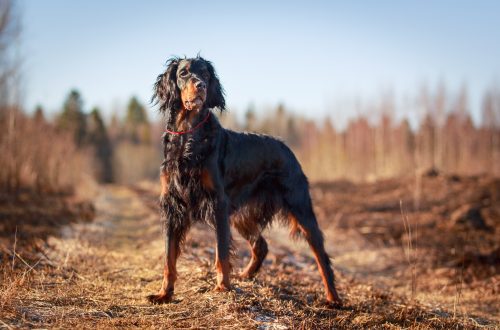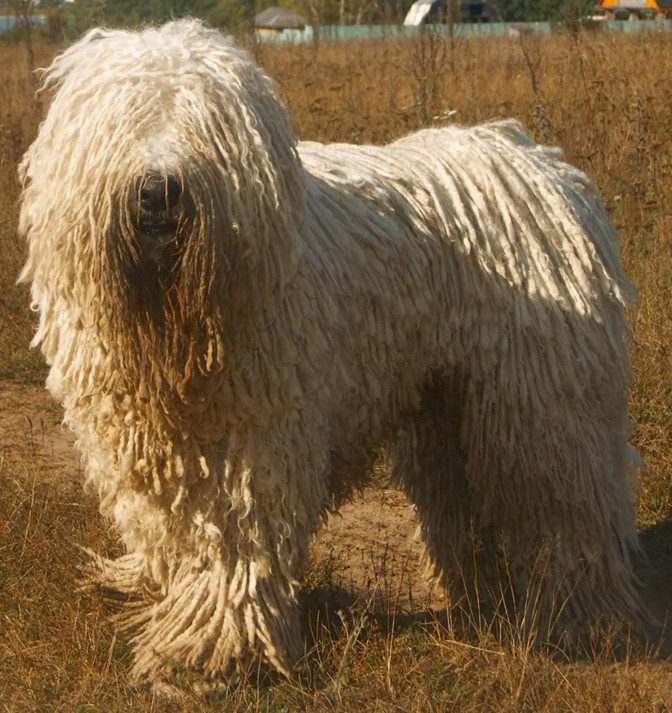
Komondor
Other names: Hungarian Shepherd Dog
The Komondor is a Hungarian shepherd dog breed with long, white hair that curls into tight cords. All members of the family have a moderately restrained character, a developed territorial instinct and the ability to make the right decisions in extreme situations.
Contents
Characteristics of Komondor
| Country of origin | Hungary |
| The size | large |
| Growth | 65–80 cm |
| Weight | 40–60 kg |
| Age | 12 years |
| FCI breed group | herding and cattle dogs, except Swiss cattle dogs |
Basic moments
- In Hungary, a legend about the origin of the breed is widespread, according to which the Komondor is the result of mating a wolf and a sheep.
- Long white “dreadlocks” on the dog’s head do not block her view, although from the outside it may seem that such a hairstyle interferes with the animal.
- Representatives of the breed grow slowly. A shepherd dog becomes fully mature only by 2-2.5 years.
- The Komondor is often referred to as a pet for the lazy, as the grooming of the dog’s coat is minimal.
- The structure of the coat of the Hungarian Shepherd Dog is a variable characteristic. Puppies are born with astrakhan fur that curls into cords as the animal matures.
- From the Komondor it will not be possible to grow an ideal servant: the blind execution of commands is not characteristic of representatives of this breed. In addition, it takes them a lot of time to think about each action.
- Due to the fact that the Hungarian Shepherd Dogs have been bred for a long time in isolation, without the influx of blood from other breeds, they practically do not have genetic diseases.
- Unusual cord-like wool is an element of disguise, which from ancient times helped shepherd dogs to remain invisible in a herd of sheep. In addition, due to the abundance of grease, the “fur coat” of the Komondor remains very dense, perfectly protecting the body of the animal from any mechanical damage.
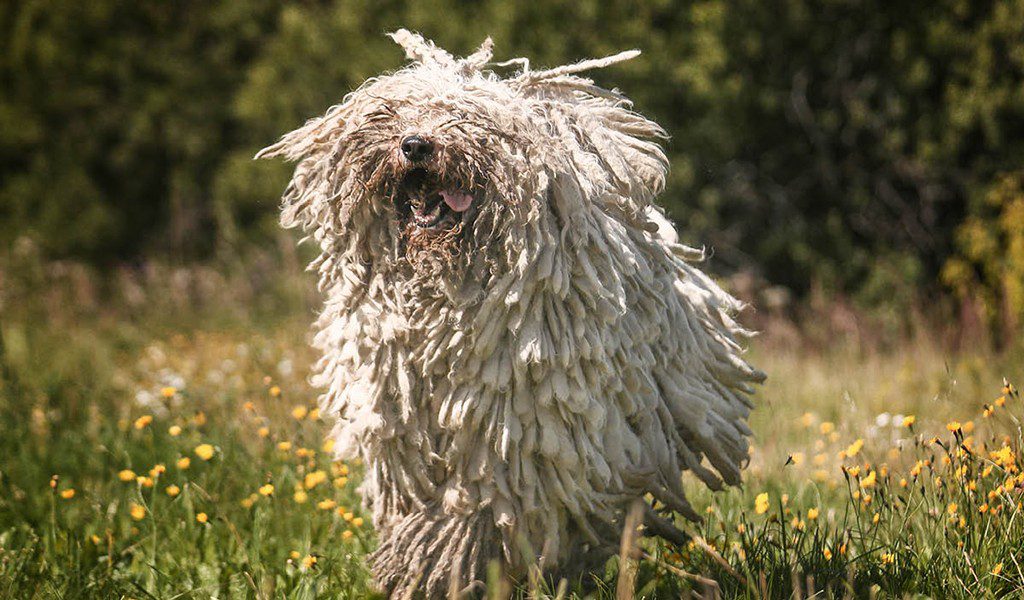
The Komondor is a charismatic giant with a coat that resembles a cross between African braids and dreadlocks. Behind this harsh “blonde” there is a serious working past, in which there was a place for both shepherd and protective and watchdog activities. Today, Komondors guarding sheep herds are a rare occurrence: since the second half of the 20th century, Hungarian shepherd dogs have more often conquered exhibition rings than looked after small artiodactyls. At the same time, the change in the field of activity had almost no effect on the instincts of the breed, so raising professional shepherds from modern Komondors is as easy as shelling pears.
History of the Komondor breed
Almost nothing is known about the ancestors of the Komondor, which gives scientists room for imagination. The most widespread theory is that the Komondors are the descendants of dogs born as a result of crossing a wolf with an ancient shepherd dog. However, when this happened, under what circumstances and with what kind of shepherd dogs, one can only guess. The original birthplace of the breed was the Northern Black Sea region, where it was bred by the Magyar tribes to protect sheep from predators and thieves. After the Khazars forced the Magyars into the territory of today’s Hungary, the dogs also left with them.
The first description of the exterior of the Hungarian Shepherd Dog was made by the Czech teacher Jan Amos Comenius, who dubbed the Komondor “the king among the shepherds.” However, centuries passed after centuries, but outside of Hungary the breed never gained popularity. Moreover, during the years of World War II, animals were almost completely exterminated. American breeders helped the Hungarians restore the number of shepherd dogs. The result of this cooperation was the emergence of the American branch of the breed, the representatives of which differed significantly from their European relatives.
The current stage in the development of the Komondor clan is usually associated with the Hungarian kennel Karcag Pusztai and its founder Jozsef Bukowski. Through the efforts of an enthusiast, the breed was able to get to international exhibitions and win the interest of foreign breeders. Actually, at the suggestion of Bukowski, dogs ended up in Soviet kennels – in 1991, the first litter of domestic Komondors was born.
At one time, the popularity of Hungarian Shepherd Dogs in Russia was quite high, which created a decent demand for puppies. However, to date, the nurseries of Romania, the Czech Republic and Hungary have pressed the domestic breeding specialists. And if earlier the export of Komondors from their historical homeland was under the official ban of the authorities, now Hungarian breeders are loyal to the fact that their wards go abroad.
Video: Komondor
Komondor Character
The Komondor is a smart, observant and quick-witted dog. Modern representatives of the breed are kind and affectionate pets that are devoted to the owner and treat children well. But to other pets and strangers, they can show aggression. Moreover, the Komondor will protect its territory and protect the family in which it lives, regardless of the desire or unwillingness of the owner.
Since this is a pet with character, he needs a calm and confident owner who can earn the respect of the animal. Komondor is a very obedient, balanced and peaceful dog, but if some order or command seems strange or incomprehensible to her, then she simply will not fulfill them. In the family, the Komondor does not strive for leadership, he is calm and complaisant. Easily trainable , although somewhat slow, so training should start at an early age.
Representatives of this breed are very hardy, they love active games and need serious physical exertion. But boredom and prolonged loneliness can negatively affect their behavior.
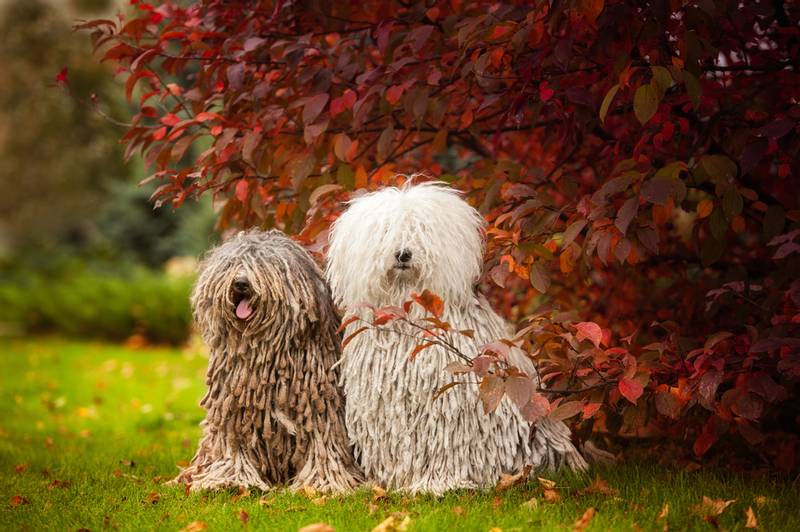
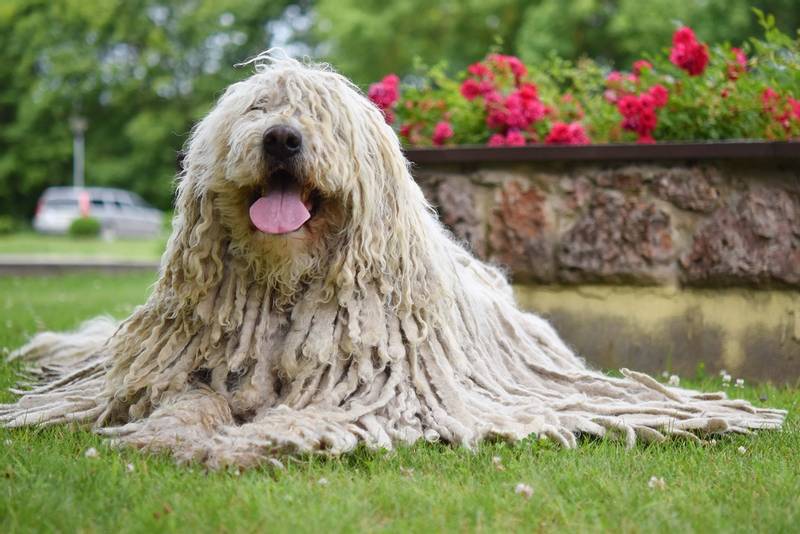
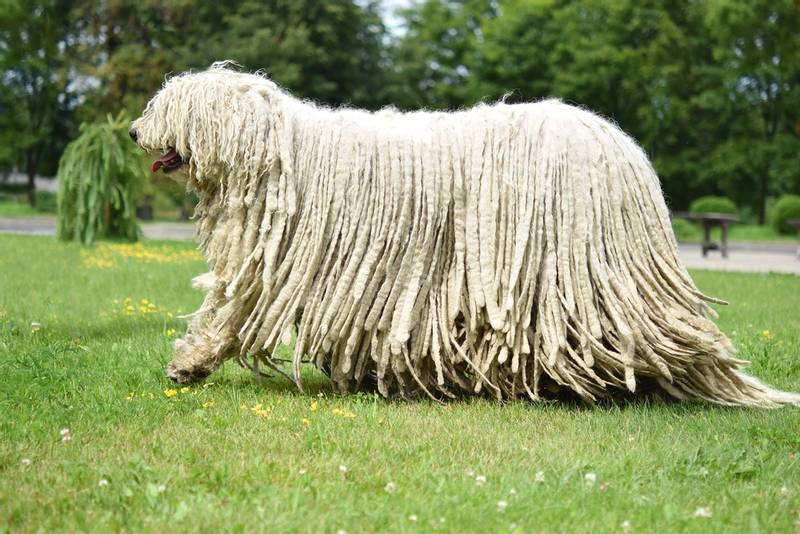
Komondor breed standard
The catchy “Rastaman” image of the Komondor is due to the unique structure of the coat, which falls into gigantic “dreadlocks”. At the same time, the essence of the representatives of the breed is serious and does not favor familiarity. Shepherd males are much more textured and larger than females. The minimum allowable height of a blond “Hungarian” is 70 cm, the optimal one is 80 cm. The lower height bar for “girls” is 65 cm. making the animal’s skeleton lighter.
The official standard recognizes only white shepherd dogs, however, throughout the existence of the breed, attempts to breed Komondors with other shades of wool did not stop. In particular, completely black dogs also lived in the kennels of Jozsef Bukowski. Today, Komondors of alternative colors are less common, and it is important to understand that these animals acquired the shade of their “fur coats” by crossing their ancestors with other breeds. This means that all “Hungarians” who have any coat except white are mestizos carrying third-party genes.
Head
Arched, convex when viewed from the side, the skull is longer than the muzzle. The head itself is shortened, with a wide forehead. The stop is clearly visible, but without excessive sharpness. The broad, coarse muzzle is of medium length.
Jaws, lips, teeth
The massive jaws of the Komondor are hidden under thick black lips. The number of teeth is 42. The standard bow of the jaws is the correct scissors.
Nose
The nasal dorsum is smooth, turning into a black lobe, the tip of which, when viewed in profile, forms a right angle.
Eyes
The iris is characterized by a dark brown tone. The shape of the eyes is oval, the presence of a black or gray edging of the eyelid is mandatory.
Ears
The ears are set on a medium U-shape and hang down along the head. The position of the ear cloth is static: the dog does not raise it in excitement and when attacking the enemy, as other shepherd dogs do.
Neck
In a resting Komondor, the neck looks like a natural extension of the back. The dimensions of this part of the body are impressive: the neck is thick, short, convex, but without dewlap.
Frame
The Hungarian Shepherd Dogs have elongated bodies with the same elongated withers and short backs. The croup of the dog is distinguished by moderate sloping and good width. The chest is barrel-shaped, stretched in length, medium deep.
limbs
Forelegs in the form of columns, with developed muscles, thick articular joints and strong bones. The shoulder blades are slightly oblique and are distinguished by a close fit to the body. The hind legs are slightly sloping. The hips of the animal are dense and voluminous due to the developed muscle mass, the shins are very strong. All representatives of the breed have impressive paws of a rounded contour with strong grayish claws.
Tail
The hanging, low-set tail of the Komondor has a slightly raised tip.
Wool
The long coat of the Hungarian Shepherd Dog is formed by outer coat and soft undercoat, tangled into thick cords resembling dreadlocks. On the lower back of the dog, the length of the coat reaches 20-27 cm. The shorter hair on the shoulders, sides of the chest and back is 15-20 cm. On the legs, ears, head and muzzle, the cords are even shorter – 10-18 cm. The chin and lips of the animal are hidden under wool only 9-11 cm long.
Important: lactating bitches, as well as malnourished and intensively working dogs, can lose part of their coat. Over time, the hair is restored and gains the necessary strength, returning the animal to its original appearance, but at an exhibition with such a pet it is easy to get the wrong grade that you expected.
Color
All komondors have a classic white suit.
Disqualifying vices
- Short hair all over the body and in some areas (not to be confused with seasonal shedding and periods of hair renewal due to pregnancy or an insufficiently balanced diet).
- Meaty skin tone on exposed areas (lips, nose, paw pads).
- Erect light ears.
- Spots on wool.
- Short or curly tail.
- Loose body, insufficiently dense condition.
- Uncontrolled aggression towards a person or cowardly behavior.
The nature of the komondor
The main character trait of the Hungarian Shepherd Dog is selectivity in communication. In relation to the owner and members of his family, the Komondor never shows aggression. On the contrary, he will be the embodiment of patience and kindness. With his own kind, the shaggy giant also builds friendly relations. The Komondor will definitely never dare to get into a fight first, therefore, he treats all four-legged brethren with curiosity and goodwill. At the same time, provoking the “Hungarian” to a conflict is not at all difficult – it is enough to yelp threateningly or step into the territory protected by him. The shepherd will not leave such rudeness unpunished, you can rest assured.
As far as the Komondor is phlegmatic and relaxed in the company of the owner, he is just as suspicious and tense in the presence of strangers. The breed is still “not letting go” of the shepherd’s past, in which every stranger approaching the herd could turn out to be a sheep thief. By the way, this feature of behavior can be easily channeled into a practical direction: “Hungarians” make first-class watchmen, vigilantly guarding the owner’s house and property. Cynologists joke that it is easy to get into the territory of the komondor, but impossible to get out. If the dog felt a real threat coming from a person or a predator, the attack will be lightning fast and merciless.
The Komondors are very sensitive to the children with whom they share their living space. To the younger generation, this “blond with dreadlocks” allows everything – hugs, riding, appropriating his toys and other things that the vast majority of shepherd dogs would not agree to. However, innate selectivity makes itself felt here as well. For example, unfamiliar babies do not arouse interest in the Komondor, but, on the contrary, they arouse slight suspicion. You should not try to “make friends” a dog with the children of friends or just familiar kids. The breed has already developed a habit at the gene level to divide people into friends and foes, so such experiments will not lead to anything good.
Education and training
In the case of the Komondor, it is better to push training into the background and concentrate on raising a pet. The reason for this is by no means the low intellectual indicators of the breed, but rather the excessive self-sufficiency of its representatives. Hungarian Shepherds belong to the category of “thinking” pets, subjecting any requirement of the owner to immediate analysis. As a result, animals easily memorize commands, but execute them once or after a certain period of time, after they have thoroughly considered the expediency of actions.
The FCI does not consider it mandatory for Komondors to attend training courses. However, to get a manageable and obedient pet, you have to sweat a little. Usually, the UGS, IPO and OKD programs are recommended for the breed with the involvement of professional cynologists. Another difficulty in training Komondor is the ability to develop obedience in a dog, while not turning into a despot master. The fact is that the “Hungarians” do not perceive the psychological pressure and, in response, they will be stubborn with redoubled energy. Accordingly, the right balance in the relationship has to be sought.
The ability of a dog to think over every requirement of a person will take some getting used to. Many inexperienced owners mistakenly believe that if the komondor does not follow the command, then he simply did not hear it. Then the demand is repeated again and again, but for the most part to no avail. In fact, Hungarian Shepherds do not have hearing problems, and repeating commands to them endlessly means demonstrating their own impotence. Give the pet time to think, and if they drag on, slightly push the dog into action with a pre-learned conditioned signal (clap, clicker).
Maintenance and care
Komondors quickly get used to living in a house or apartment, if the living space allows you to place a dog of this size without compromising the comfort of an animal and a person. Enclosure is also possible, but only if there is an insulated booth and a wooden flooring. It is strictly forbidden to put an animal on a chain: freedom-loving komondors will not endure such a test.
Hygiene and hair care
Komondor is a dog with which you can completely forget about such an object as a comb. Puppies are born in delicate astrakhan fur coats, which turn into hard and rather dry coats by 5 months, which are strictly forbidden to comb. Instead of combing with a comb, breeders recommend periodically “sorting out” the Komondor hair by hand, passing it through your fingers. This procedure is carried out only with individuals who have reached the age of 8 months in order to prevent the appearance of tangles.
Washing the shepherd is also mandatory, because the woolen cords that cover the croup, thighs and lower abdomen often get urine that emits an unpleasant odor. An alternative to bathing can be picking up wool on the thighs and lower abdomen in ponytails, grabbed by rubber bands. This method allows the dog to more accurately go to the toilet without dirtying the long dog. Wash Komondor dogs with hypoallergenic shampoos for dogs as they get dirty. A bathed shepherd looks very unsightly, because the coat becomes grayish and seems unwashed, but this is exactly until the animal dries.
Speaking of drying, prepare a powerful hair dryer or a dozen towels. The wool of the “Hungarians” dries for days, so you will have to speed up the process in every possible way. The best option is to bathe the shepherd dog living in the apartment for the night. Of course, the Komondor will not dry out completely during this time, so the time of the morning walk will have to be reduced as much as possible, dressing the pet in protective overalls for safety. As for the yard dog, after washing it will have to be placed in a heated room for a while so that the animal dries normally and does not catch a cold.
The hair between the paws of the Komondor needs to be cut regularly so that it does not interfere with movement. Corded curls on other parts of the body are strictly forbidden to touch. An exception is working individuals dissecting meadows, for which wool shearing is indicated for hygienic reasons. Always pay attention to the chin area and ears. The hair on the muzzle gets dirty every time the dog eats and drinks, which creates an ideal breeding ground for bacteria. So that fungi that provoke skin diseases do not start in the Komondor’s beard, each time after eating, the dog’s muzzle must be wiped with a dry, clean cloth or napkin.
Careful care is necessary for the ears. In the “Hungarians” they are tightly pressed to the head and covered with thick hair, which makes it difficult for air to enter the funnel. The ear cloth should be regularly inspected and ventilated by hand, removing dirt and excess sulfur with clean wipes or digging inside hygienic ear lotions from a veterinary pharmacy.
Feeding
Not only the health and well-being of the Komondor, but also the structure of its coat depends on a properly composed diet. It happens that with a lack of certain vitamins and trace elements, the hair of the breed is poorly twisted into cords, and the undercoat becomes rare. The choice of the type of food remains with the owner. The dog itself can exist quite happily, eating both high-quality “drying” and “natural”.
The main products that will be useful to the Hungarian Shepherd Dog are: buckwheat and rice porridge cooked on water, flavored with boiled vegetables (except legumes and potatoes), lean beef and tripe, raw liver, boiled offal. The menu should add low-fat cottage cheese and kefir, which are sources of calcium and protein. Puppies are given meat from a month and a half. The standard rate of meat products for komondor by age:
- from 1.5 to 2 months. – 150 g/day;
- from 2 to 3 months – 200 g/day;
- from 3 to 4 months – 300 g/day;
- from 4 to 5 months – 400 g/day;
- from 5 to 6 months – 500 g/day;
- from 6 months and further – 600 g.
Once a week, the meat is replaced with boiled sea fish (fillet). However, due to the reduced calorie content, the weight of the fish portion should exceed the proportion of meat by at least 20%. Twice a week, the komondor is offered a chicken egg – a whole boiled egg or a raw yolk. As tasty incentives in the process of training, you can use rye crackers, unsweetened dryers and biscuits. And of course, always keep dietary supplements with glucosamine and chondroitin on hand – the joints of the breed are not the most hardy.
Important: for Komondors who constantly live on the street (aviary, booth), there are increased nutritional standards for the seasons. For example, in summer, the calorie content of the diet of yard pets should be 15% higher than that of apartment dogs, and in winter – by 25-30%.
Health and disease of the komondor
Hungarian Shepherds were lucky in the sense that professional breeders were not interested in them for a long time. As a result, many genetic diseases that are usually provoked by interbreeding have bypassed the Komondor. In particular, despite a solid physique, representatives of this family do not suffer from hereditary and age-related hip dysplasia. Articulation problems can make themselves felt, but mostly during adolescence, as Komondor puppies grow very unevenly. Jogging and walking at a fast pace (only acceptable for young dogs), chondroprotectors and a balanced diet help to avoid deformation of the articular tissue.
How to choose a puppy
- Please note that the coat of Komondor puppies is not yet cord-like, but curly and fluffy. Full-fledged “dreadlocks” in Hungarian shepherd dogs appear by the age of two.
- Always be interested in the age of the producers. RKF does not register offspring from Komondor bitches who are under 18 months old.
- Usually, Hungarian Shepherd dogs are more severe in nature and less capable of learning than females. For grazing and protection of the territory, it is recommended to choose a male animal.
- Carefully inspect the puppy’s tail. The congenital bend on this part of the body is sometimes confused with such an exterior defect as a hall. To make sure you don’t have a defective baby, try to straighten the “curl” – this is usually easy to do. In addition, the correct curve will often straighten out on its own when the puppy is sleeping.
- Skinny or too well-fed Komondor babies are not considered an enviable acquisition. It is optimal when the puppy is in moderate condition.
- Place your palm in a horizontal position (fingers forward) and try to push it into the space between the front legs of the Hungarian Shepherd puppy. If the hand does not pass, the set of limbs is too narrow, which is considered a defect in the exterior.
Komondor price
The average cost of a Komondor puppy from Russian breeders is 750$. But as the popularity of the breed in the country has declined in recent years, finding a trustworthy seller will take effort. As an alternative, you can consider buying a dog from Hungarian kennels like “Somogy Betyar”. Many of them are ready to give the buyer the necessary documents for the export of the komondor and assist in every possible way in quick transportation.





